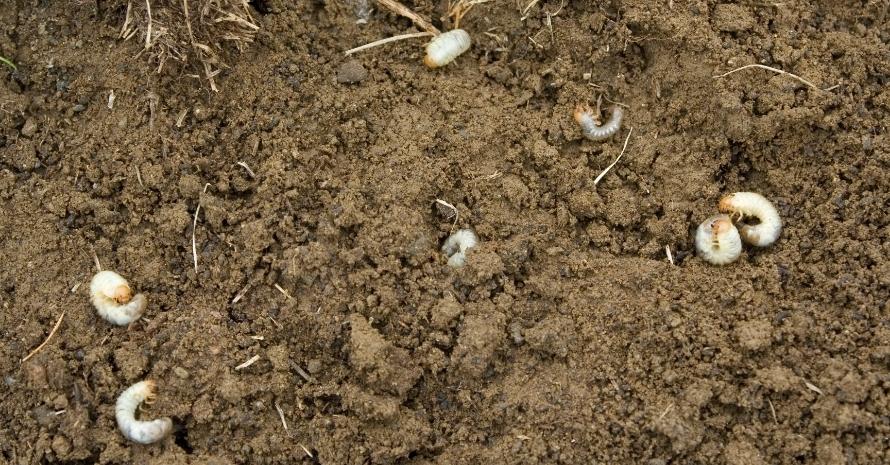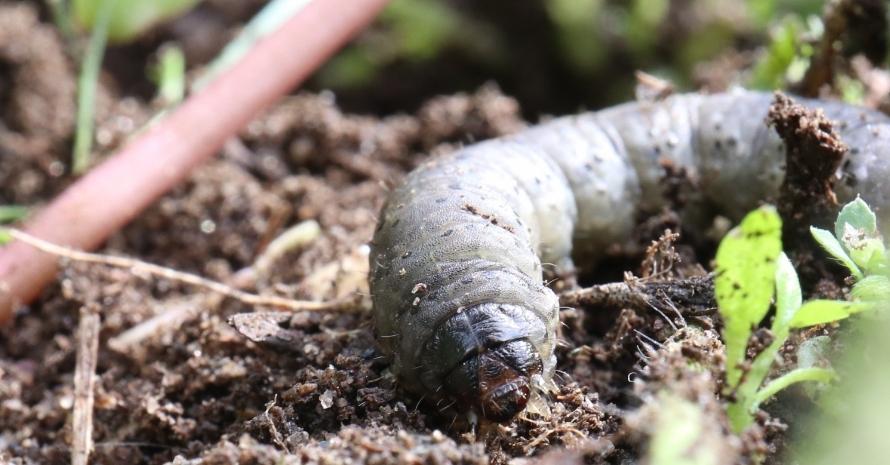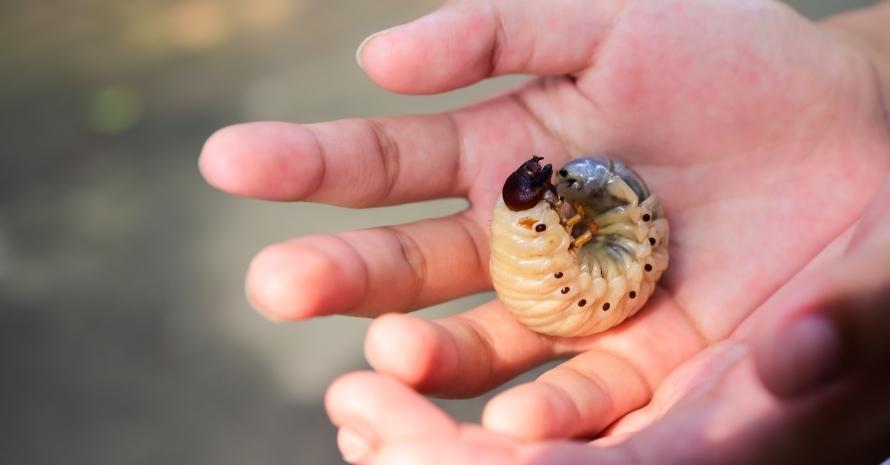If you think of larvae as utterly helpless and thus harmless creatures, you should probably reconsider it. Numerous house owners across the US are asking how to get rid of grubs in lawn soil because the little squirmy things have completely destroyed their turf.
Fortunately, it turns out you can get rid of grubs in the lawn naturally and implement good lawn-keeping practices to never face this problem again. I wrote this article so that you can understand what causes grubs in your lawn and what to do about the infestation. The FAQ section at the end provides concise answers to some grub-related questions I get asked a lot.
Guide on How to Kill Grubs in the Lawn
- Start with curative treatment. You can apply either a granular or liquid pesticide that is recommended for fixing the grub problem;
- Alternatively, try using nematodes or milky spore disease for natural pest control;
- Apply preventive measures such as preventive pesticides and encouraging birds around your lawn;
- Keep your lawn well-fed and well-watered to prevent reinfestation.
What are grubs in the lawn?
There is a widespread misconception that white or brown grubs in lawn soil are worms. This can clearly be attributed to the creatures’ characteristic appearance, in particular a C-shaped sectioned body.

It turns out, however, that the term “white grubs” in lawn context relates to larvae of the so-called Scarabaeidae beetles. The color designation is a bit of a misnomer because some of the above beetles produce larvae that are only partly white or even dark in color.
The variety of scarab beetle species found in the United States is rather wide. Previously, the Japanese beetle was heavily predominant, but nowadays the so-called oriental, Asiatic garden, and European chafer beetles are also becoming increasingly widespread.
Grub damage
Beetle larvae known as grubs can damage your lawn heavily by munching on the roots of the grass closer to the soil. This usually happens in late summer as well as in fall. Since the roots supply the grass with nutrients and water, it loses its vigor without them, which causes discoloration (yellow patches where the grass has already started to thin out and die) and the phenomenon when your lawn rolls up pretty much like a carpet.
Apart from the direct damage that white grubs in the lawn can cause when they take residence, there’s the secondary harm of animals that hunt them. These include moles, skunks, and raccoons. They will dig into the soil in search of nutritious larvae, damaging the turfgrass and often leaving its roots exposed and largely doomed.

In cases where property owners choose not to take any pest control measures against white grubs, they often end up facing an infestation of grown beetles, too, which manifests itself rather differently. Adult individuals will feast on leaves and flowers, leaving the plants skeletonized and miserable-looking. The highly common Japanese beetle prefers roses, linden trees, and grapes.
Signs of grubs in lawn soil
There are several signs to look for if you suspect that you might have grubs. Also, if you live in an area where at least one of the above beetle species is common, you should be suspicious all the time. Here’s a list of problems that are usually indicative of grub trouble:
Patches of dead grass
The patchy lawn appearance is very typical of grub-saddled turf in general. If you see yellow or brown spots that look unhealthy and thinned out, this is a sure sign someone is consuming the roots of the grass, leaving it undernourished and weakened.
Spongy turf
When the roots are heavily damaged, grass will pull up all too easily, leaving you with the impression of a carpet. Conversely, healthy turf is springy and elastic.
Visible grubs
If you see C-shaped milky-white larvae, sometimes with darker parts such as heads, in soil samples from your lawn, the bad news is you have grubs. The good news is that it is not necessarily a disaster. If you only find a fewб and it doesn’t look like the soil is rife with beetle larvae, you shouldn’t expect great damage to the turf. However, serious grub presence is a sure sign that you should take measures
Increased raccoon, mole, or bird activity
Vertebral pests that feed on insects are most likely to be attracted to your lawn if it’s full of beetle larvae. If you notice an unusual agitation, be sure to carry out an inspection (see below to find out how to do it).
Checking for grubs
Checking your lawn for common turf problems should be part and parcel of your gardening/lawn care routine. Winter is the only time you don’t need to be apprehensive of grub damage. Since grubs generally pupate around mid-May, they cause most damage until that time, beginning in March. Autumn months are also associated with an increased risk of root weakening caused by hungry larvae.

Typically, there’s no need to take soil samples and look for grubs proactively because their overpopulation manifests itself in signs that make them hard to confuse with any other pest. Watch out for any signs of changes in turf color and structure, usually discolored, thinned-out areas, as well as other signs described above. Take the following steps if you notice any of those:
- Try tugging on the turf to see whether it rolls up easily;
- Use a shovel to dig the soil about 3 inches deep and see if there are any grubs in it. If yes, proceed to implement or enhance grub control.
How to get rid of grubs in the lawn (step-by-step guide)
There are two main ways in which you can address the issue of beetle larvae feeding on your turf roots, chemical and natural control. The latter is also commonly referred to as organic grub management, but this can be misleading because the term “organic” is also applicable to certain chemical agents that can be used for this purpose.
Before we focus on the differences between the two approaches and pick the one that is more fitting for your situation, you should understand a key idea to solve the grub problem. Every life stage of a pest is different in terms of the conditions that it can or can’t withstand. What has every chance of killing an adult beetle might prove useless against a grub.
Then there are eggs, which generally hatch within 10 days from the time they are laid, making effective grub control even more of a challenge. You need to make sure that your lawn isn’t as welcoming for grubs as it used to be following any treatment, whether it’s chemical or natural, and never fail to keep an eye on it in case they return.
Chemical grub control
When people ask about the best way to kill grubs in lawn soil, most of them think of chemical agents known as insecticides. This is the term for substances toxic to pests and harmless, or at least less harmful to the plants they are meant for. When it comes to grubs, there are two major categories of chemical control agents on the market, preventative products and curative ones.
Step 1
The former group of products should be applied in early summer to ensure protection against grub during the coming fall and next spring. It is not what you should focus on if you are already facing an infestation in late spring because the dosage of insecticides in such solutions is not normally enough for curative treatment.
However, it’s always wise to apply some for a year or two following a proven case of grub presence. This will enable your lawn to grow a thicker, stronger turf in the meanwhile, which is more resistant to pests.
Step 2
Curative products are harsher and can only be applied in early Spring or early fall, up to late October. You might want to resort to them if you didn’t have much success with the prevention or didn’t use any; in this case, it’s a good idea to also use preventative lawn care solutions afterward.
There are numerous options in both categories these days, including integrated pest management certified agents such as those based on natural neem oil, a viable solution in case you are apprehensive of harsher treatment.
It’s important to pick a product that deals specifically with grubs and closely follow the instructions for use, which will likely include using a specific mode of application and watering the turf immediately afterward.
Natural grub control
Now that integrated pest management is becoming increasingly popular, and lawn owners try to avoid harsh insecticides unless absolutely necessary, grub control methods that would probably sound quirky a couple of decades ago seem to be all the rage with a lot of evidence to support their use.
Consider introducing beneficial nematodes to your turf as a way of protecting it against grubs. These parasites will weaken the pests and eventually drive them to death naturally, without any harm to the rest of the ecosystem.
The right time for applying nematodes would be on a rainy, cloudy day around mid-August as they need moisture to get deep enough into the soil where they can start interacting with the grubs.
Milky spore disease is another option for controlling the grub population naturally, although there are probably not as many proven success cases as with nematodes. Whichever natural enemy you choose, be sure to combine it with healthy lawn practices as a vigorous turf will have less trouble resisting grubs.
This should include adequate watering and cutting your lawn regularly. Parched soil and undernourished plants are a recipe for disaster when a gang of starved larvae happens to land in it. White grubs are highly unlikely to cause noticeable damage to a healthy lawn, though.
FAQ on How to Control Grubs in Your Lawn

This section offers very brief answers to some of the most common questions when it comes to grub control and prevention. You will find more details on each of these subjects in the above sections, so make sure to read the respective part of the article if you feel like you need more clarity.
How to check for grubs in the lawn?
It’s usually a good idea to start with a visual check. Grubs are more common than you might think, which means the probability of seeing one if you take a soil sample is rather high. Instead, you should look for signs of weakened grass such as yellowing and thinning out. If there are indications of grub presence, try digging into the lawn with a shovel to see if the soil is rife with beetle larvae.
How to control grubs in the lawn?
Combine appropriately timed preventative chemical treatment or biological prevention with curative chemical products while also maintaining a healthy, well-nourished, and well-watered lawn. There’s no need to exterminate grubs completely. After all, your turf can survive a bit of their activity unless it’s already weakened.
What is the best time to treat your lawn for grubs?
This depends entirely on the type of treatment you use. Preventative products are normally applied in the first two months of fall, while others are meant for use in late spring. Finally, if you choose nematodes for biological control, it’s best to introduce them on a day in mid-August with lots of precipitation.
What kills grubs the fastest?
Curative insecticide-based products targeting grubs are the quickest way to get rid of the larvae, but there’s no guarantee their effect will last unless you also apply prevention. Generally, chemical treatments work quicker than natural ones.
Keep Your Lawn Lush Green
Appropriate timing and a combination of preventative and curative approaches work best for protecting your lawn against biting beetle grubs. Use a grub insecticide according to the instructions if you are dealing with the infestation, backing it up with a preventative product as well, or try introducing beneficial natural enemies of the bug instead, such as nematodes or the so-called milky spore disease.
Have you ever had grubs in your lawn? How did you spot them? Share in the comments.

